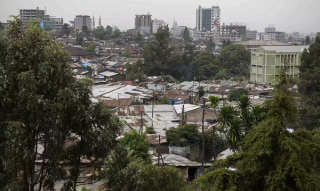Support for women’s and girls’ care in Addis Ababa
12 February 2018
Late last year, Joanna Goodrich and Bev Fitzsimons travelled to Ethiopia to provide training in our Sweeney programme to staff at new hospitals for women and girls. Despite many contrasts with the UK, local healthcare staff were facing a similar challenge of rising demand and recognised the value of empathy in delivering high quality care.
Topics

Teaching our Sweeney programme in Ethiopia in December proved to be one of the highlights of 2017. Bev Fitzsimons and I had been invited to ‘train the trainers’ at the Centre for International Reproductive Health Training (CIRHT) at St Paul’s hospital medical school in Addis Ababa. Eleven new Michu clinics for women, (‘michu’ meaning ‘comfort’ in Amharic) are opening across the country, offering a comprehensive reproductive health service, and the staff are all being trained through CIRHT.
CIRHT is a University of Michigan initiative with medical schools to provide the health workforce with hands-on clinical training, patient service and research.
Within the Michu Clinic, staff learn how to work with a woman or girl to address her individual needs, whether it is through skilled communication and counselling on a full range of contraceptive methods, or comprehensive abortion care. Although the services we saw in Addis contrasted greatly with our own, there was much commonality too: services there are also struggling to meet the demands on them, yet clinical staff have evident empathy with the situation of their patients, and of the demands on their colleagues. The methods we use in our Sweeney programme were equally as applicable in Ethiopia as they are at home.
Our audience was a mixed group of doctors and nurses from the CIRHT team and staff from two Michu clinics in Addis. We understood that this was the first time they had worked together. The training we offered had the usual aims:
- To understand what is meant by patient-focused quality improvement
- To be equipped with a method and range of tools to enable them to understand patients’ experience and see it through their eyes
- To understand what is meant by co-design
- To be equipped with a method and range of tools to turn co-designing improvements with patients into practice
Using a number of interactive exercises we asked small mixed groups of nurses and doctors to work together, focusing on an improvement project they had in mind in their clinics. First, they mapped all the stakeholders they would need to involve to make the project a success, and this, combined with mapping the process the women and girls go through, resulted in identifying a large range of important people, from the guards on the clinic gate onwards.
Access for women and girls
As a design challenge, the team identified the issue of how women and girls get access to the clinic as an area for improvement. The clinic at St Paul’s shares an entrance with the busy hospital entrance, including the A&E department. The course participants rightly identified this as a daunting prospect for women and girls seeking help from the Michu clinic.
We worked to share tools to help them to discover the experience that both staff and patients have of the service, and discussed the sensitivities involved in interviewing and recording or filming the girls and women when there is a stigma attached to their seeking help at the clinics. We were working with an expert local team, Impala Communications, who will be making trigger films for the co-design projects. Clearly our UK films were not appropriate to use as examples, and Dr Munir, Director at CIRHT, provided a recently made film telling the story of one woman’s journey to the Michu clinic and the consultation she had, simultaneously translating it into English for our benefit. Exercises on observation and shadowing and emotional mapping followed.
Several of the group were familiar with the Model for Improvement, and on the second day we showed how the Sweeney programme’s patient-focused approach complements it. Prototyping and the ‘Plan-Do-Study-Act’ method were illustrated with the help of a couple of oranges. Together we used an exercise to generate ideas for improvement which the groups will use when they go back to run the events with patients and staff in their clinics. They referred to the design challenge of improving access to the clinics, and came up with several possible solutions: examples were better information about the clinics for the guards on the gate to help them assist the women attending; increasing the use of volunteers in Michu uniform, to help people find their way through the queue to find the clinic; improved education for the reception staff; through to creating a new gate and a separate entrance for the clinic. Again, much as they do at home, these practical exercises energised and enthused the trainees.
Neither I nor Bev had been to Ethiopia before and we thoroughly enjoyed our time. We learned a lot too, not least how to work without PowerPoint when there was a power cut for half of our first day, and how true it is that the way to learn is through doing. We always say that quality improvement is all about building relationships and we saw how that should start with the way we run our training – less talk and more doing!
By the end of our time we felt that, thanks to the enthusiasm of everyone there and the leadership of Dr Munir, that three projects were well underway.
Find out more about our Sweeney programme
Find out more about Michu Clinics